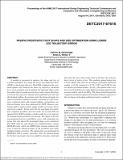Passive Prosthetic Foot Shape and Size Optimization Using Lower Leg Trajectory Error
Author(s)
Olesnavage, Kathryn; Winter, Amos G.
Downloadv05at08a011-detc2017-67618.pdf (1.733Mb)
PUBLISHER_POLICY
Publisher Policy
Article is made available in accordance with the publisher's policy and may be subject to US copyright law. Please refer to the publisher's site for terms of use.
Terms of use
Metadata
Show full item recordAbstract
A method is presented to optimize the shape and size of a passive prosthetic foot using the Lower Leg Trajectory Error (LLTE) as the design objective. The LLTE is defined as the root-mean-square error between the lower leg trajectory calculated for a given prosthetic foot by finding the deformed shape of the foot under typical ground reaction forces and a target physiological lower leg trajectory obtained from published gait data for able-bodied walking. In previous work, the design of simple two degree-of-freedom analytical models consisting of rigid structures, rotational joints with constant stiffness, and uniform cantilevered beams, have been optimized for LLTE. However, prototypes built to replicate these simple models were large, heavy, and overly complex. In this work, the size and shape of a singlepart compliant prosthetic foot keel made out of nylon 6/6 was optimized for LLTE to produce a light weight, low cost, and easily manufacturable prosthetic foot design. The shape of the keel was parameterized as a wide Bézier curve, with constraints ensuring that only physically meaningful shapes were considered. The LLTE value for each design was evaluated using a custom MATLAB script, which ran ADINA finite element analysis software to find the deformed shape of the prosthetic keel under multiple loading scenarios. The optimization was performed by MATLAB's built-in genetic algorithm. After the optimal design for the keel was found, a heel was added to structure, sized such that when the user's full weight acted on the heel, the structure had a factor of safety of two. The resulting optimal design has a lower LLTE value than the two degree-of-freedom analytical models, at 0.154 compared to 0.172, 0.187, and 0.269 for the two degree-of-freedom models. At 412 g, the optimal wide curve foot is nearly half the mass of the lightest prototype built from the previous models, which was 980 g. The design found through this compliant mechanism optimization method is thus far superior to the two degree-of-freedom models previously considered.
Date issued
2017-08Department
MIT-SUTD Collaboration; Massachusetts Institute of Technology. Department of Mechanical EngineeringJournal
Volume 5A: 41st Mechanisms and Robotics Conference
Publisher
ASME International
Citation
Olesnavage, Kathryn M., and Amos G. Winter. “Passive Prosthetic Foot Shape and Size Optimization Using Lower Leg Trajectory Error.” Volume 5A: 41st Mechanisms and Robotics Conference (August 6, 2017).
Version: Final published version
ISBN
978-0-7918-5817-2